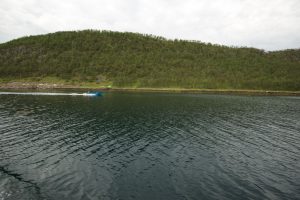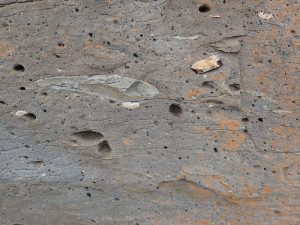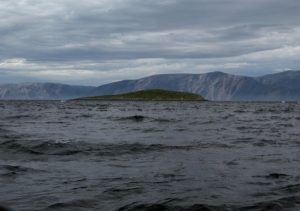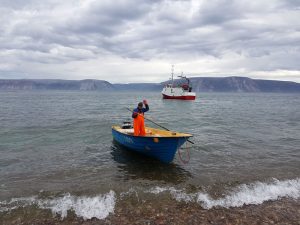By Heda Agić
Past field seasons have intrigued us about what lies “beyond the horizon”. For a more complete picture of the traces of early life preserved in Digermulen rocks, the team would have to reach areas a long way away from the traditional campsites than attempted previously. Yet it is not always possible to reach these locations on foot. Either they’re too far away (Digermulen has no roads apart from thousands-of-years-old reindeer trails), and sometimes the outcrops of interest lie on steep cliffs impossible to get down to without climbing gear. As a solution to our exploration woes, we have decided to use a small boat to hop on/off various vistas and points of interest.

Figure 1. Team en route to check a few outcrops before getting to the first campsite at Breidvika valley. Photo Wendy L. Taylor.
The vessel is a simple fishing motorboat driven by the local fisherman Trygve (Figure 1).
While the group loaded the gear for the next couple of weeks and boarded the larger fishing boat of captain Joachim, a smaller party of three geologists/palaeontologists set out with the small boat to visit a few localities before reaching the first campsite. The initial leg of our journey was pleasant, with only light cloud coverage. We ate packed lunch on the boat, while scrutinizing the passing outcrops. The first stop was reached at 1 o’clock: the Mortensnes diamictite (Figure 2), a deposit of one of the global glaciation events in the Neoproterozoic Era (“Snowball Earth” ice house).

Figure 2. Large rock pieces deposited in the finer grained sediment are an indicator for glacial activity. Photo Jan Ove R. Ebbestad.
The sea got wavier as we approached our stop. Trygve deemed it impossible to take the boat ashore on a pebbly beach nearby. We would have to get out straight to the ledges. Thick coverage of slimy brown algae made it easy to grab onto something while climbing onto the cliff-face, yet it also made it tricky to balance on. As we eagerly sampled, the seas became even more restless. It was time to go. However, our blue boat couldn’t come as close to the ledge as before. Ok, samples first then – they’re more important than the geologists. A swing – and the sample box hit the boat. Phew. Geologists’ turn. The boat was swaying away, threatening to leave us on the diamictite for good, while the colleague on the boat desperately tried to hold onto the slippery, treacherous algae.
There will have to be a jump. So jump I did, as the boat suddenly jerked away from the rocks, and for a moment I thought I would end up in cold Arctic waters much like Ben Stiller in his faithful jump in “The Secret Life of Walter Mitty”.

Figure 3. Passing Arasuola island. Photo Heda Agić
Alas, I managed to land safety, albeit ungracefully. Soon, the entire party was on board, successfully avoiding a close encounter with the fjord. But not for long. The sea got choppier and the waves kept crashing inside the boat, blinding all three bespectacled geologists with salty spray. We kept clutching onto precious samples. Digermulen field season 2016 has begun with a free rollercoaster ride! A bumpy hour later, we reached dry land before the rest of the team in the bigger ship.

Figure 4. Trygve in the small blue boat, after dropping us off on stable ground. Photo Bianca Harrison.
